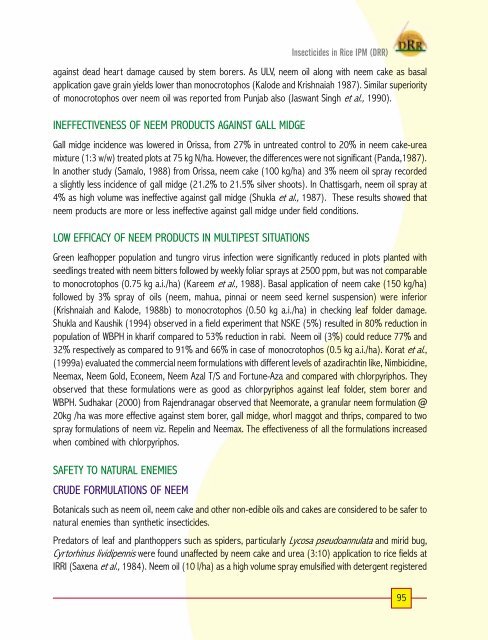priciples of insecticide use in rice ipm
priciples of insecticide use in rice ipm
priciples of insecticide use in rice ipm
You also want an ePaper? Increase the reach of your titles
YUMPU automatically turns print PDFs into web optimized ePapers that Google loves.
Insecticides <strong>in</strong> Rice IPM (DRR)<br />
aga<strong>in</strong>st dead heart damage ca<strong>use</strong>d by stem borers. As ULV, neem oil along with neem cake as basal<br />
application gave gra<strong>in</strong> yields lower than monocrotophos (Kalode and Krishnaiah 1987). Similar superiority<br />
<strong>of</strong> monocrotophos over neem oil was reported from Punjab also (Jaswant S<strong>in</strong>gh et al., 1990).<br />
INEFFECTIVENESS OF NEEM PRODUCTS AGAINST GALL MIDGE<br />
Gall midge <strong>in</strong>cidence was lowered <strong>in</strong> Orissa, from 27% <strong>in</strong> untreated control to 20% <strong>in</strong> neem cake-urea<br />
mixture (1:3 w/w) treated plots at 75 kg N/ha. However, the differences were not significant (Panda,1987).<br />
In another study (Samalo, 1988) from Orissa, neem cake (100 kg/ha) and 3% neem oil spray recorded<br />
a slightly less <strong>in</strong>cidence <strong>of</strong> gall midge (21.2% to 21.5% silver shoots). In Chattisgarh, neem oil spray at<br />
4% as high volume was <strong>in</strong>effective aga<strong>in</strong>st gall midge (Shukla et al., 1987). These results showed that<br />
neem products are more or less <strong>in</strong>effective aga<strong>in</strong>st gall midge under field conditions.<br />
LOW EFFICACY OF NEEM PRODUCTS IN MULTIPEST SITUATIONS<br />
Green leafhopper population and tungro virus <strong>in</strong>fection were significantly reduced <strong>in</strong> plots planted with<br />
seedl<strong>in</strong>gs treated with neem bitters followed by weekly foliar sprays at 2500 ppm, but was not comparable<br />
to monocrotophos (0.75 kg a.i./ha) (Kareem et al., 1988). Basal application <strong>of</strong> neem cake (150 kg/ha)<br />
followed by 3% spray <strong>of</strong> oils (neem, mahua, p<strong>in</strong>nai or neem seed kernel suspension) were <strong>in</strong>ferior<br />
(Krishnaiah and Kalode, 1988b) to monocrotophos (0.50 kg a.i./ha) <strong>in</strong> check<strong>in</strong>g leaf folder damage.<br />
Shukla and Kaushik (1994) observed <strong>in</strong> a field experiment that NSKE (5%) resulted <strong>in</strong> 80% reduction <strong>in</strong><br />
population <strong>of</strong> WBPH <strong>in</strong> kharif compared to 53% reduction <strong>in</strong> rabi. Neem oil (3%) could reduce 77% and<br />
32% respectively as compared to 91% and 66% <strong>in</strong> case <strong>of</strong> monocrotophos (0.5 kg a.i./ha). Korat et al.,<br />
(1999a) evaluated the commercial neem formulations with different levels <strong>of</strong> azadiracht<strong>in</strong> like, Nimbicid<strong>in</strong>e,<br />
Neemax, Neem Gold, Econeem, Neem Azal T/S and Fortune-Aza and compared with chlorpyriphos. They<br />
observed that these formulations were as good as chlorpyriphos aga<strong>in</strong>st leaf folder, stem borer and<br />
WBPH. Sudhakar (2000) from Rajendranagar observed that Neemorate, a granular neem formulation @<br />
20kg /ha was more effective aga<strong>in</strong>st stem borer, gall midge, whorl maggot and thrips, compared to two<br />
spray formulations <strong>of</strong> neem viz. Repel<strong>in</strong> and Neemax. The effectiveness <strong>of</strong> all the formulations <strong>in</strong>creased<br />
when comb<strong>in</strong>ed with chlorpyriphos.<br />
SAFETY TO NATURAL ENEMIES<br />
CRUDE FORMULATIONS OF NEEM<br />
Botanicals such as neem oil, neem cake and other non-edible oils and cakes are considered to be safer to<br />
natural enemies than synthetic <strong><strong>in</strong>secticide</strong>s.<br />
Predators <strong>of</strong> leaf and planthoppers such as spiders, particularly Lycosa pseudoannulata and mirid bug,<br />
Cyrtorh<strong>in</strong>us lividipennis were found unaffected by neem cake and urea (3:10) application to <strong>rice</strong> fields at<br />
IRRI (Saxena et al., 1984). Neem oil (10 l/ha) as a high volume spray emulsified with detergent registered<br />
95











